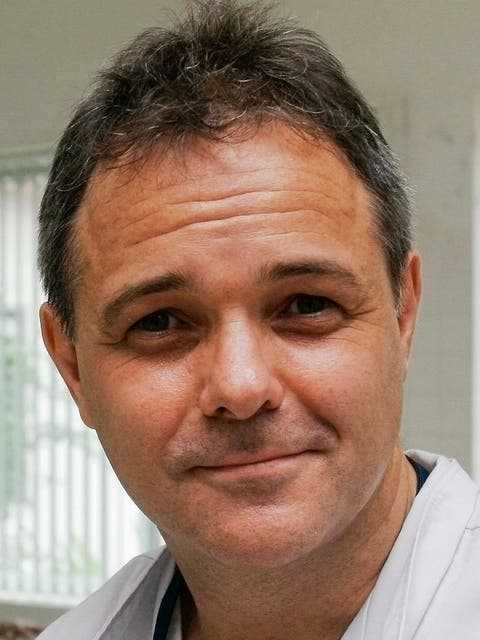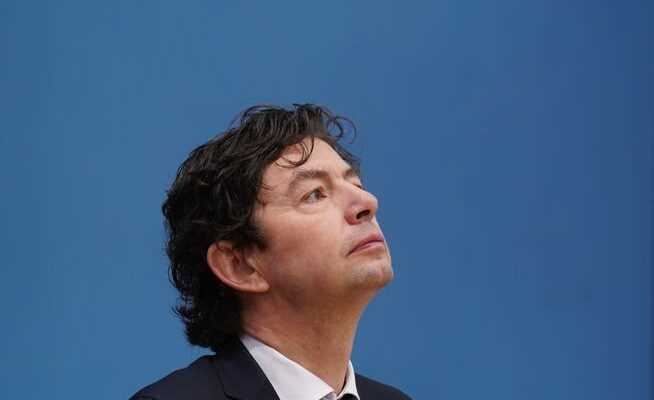In an interview, Christian Drosten talks about a groundbreaking conference call at the beginning of the pandemic. At that time, leading virologists fundamentally changed their assessment of the laboratory thesis. The host of the video link described those dramatic days in a book.
Christian Drosten at a media conference in Berlin at the end of January.
The term “conspiracy theory” in connection with a possible laboratory accident in Wuhan was not coined by the media, but by scientists. Hamburg-based nanoscientist Roland Wiesendanger made this accusation in an interview with the NZZ last week. In a highly acclaimed article that appeared in the journal Lancet in mid-February 2020, the scientists “misled the whole world,” says Wiesendanger. In that post – strictly speaking it is a “letter to the editor”, i.e. a letter to the editor – the laboratory thesis was equated with a conspiracy theory. That only fuels fear, rumors and prejudices, the scientists warned. Christian Drosten was one of the signatories at the time.
In an interview with the “Sueddeutsche Zeitung” says Drosten, like other scientists, he put his hand in the fire for his colleagues in Wuhan. However, he and the co-signers were not informed about certain projects. “If I had known about it, I would have at least had questions before I signed.” Drosten heads the Institute for Virology at the Berlin Charité. During the corona pandemic, he made a name for himself in Germany as the voice of science.
“Dangerous Things”
In the interview, he says that he too was surprised by later reports that the Institute of Virology in Wuhan had carried out so-called gain-of-function experiments – experiments in which viruses are manipulated in the laboratory in order to be more contagious for people. According to Drosten, things have been done that could be described as dangerous. But the Sars-CoV-2 virus could not come out. “They have built new properties into bat viruses, but not those that could be considered the predecessors of Sars-CoV-2.” But such experiments “really didn’t have to be,” says Drosten in an interview.
On February 1, 2020, Drosten was part of a panel of experts who discussed the origin of the pandemic in a one-hour conference call. Also taking part in this video link were Anthony Fauci and Francis Collins from the American health authorities. In previous years, Fauci and Collins had approved research funds for the gain-of-function research in Wuhan mentioned by Drosten. These funds often flowed through the non-profit organization Eco Health Alliance. Its director Peter Daszak, in turn, was responsible for the article in “Lancet”.
The e-mail traffic before and after the telephone conference that became public shows that several virologists initially considered a laboratory accident to be plausible. In later articles – in addition to “Lancet” also in “Nature Medicine” – the same virologists came to the opposite conclusion. In an interview with the NZZ, Wiesendanger suspected that leading virologists had been massively influenced or had been influenced – by Anthony Fauci, Francis Collins and other stakeholders. Wiesendanger accuses the scientists of misleading the public.
“Completely normal exchange”
Drosten vehemently defends himself against this accusation in an interview with the “Süddeutsche Zeitung”. The conversation on February 1, 2020 was a completely normal exchange between scientists. Various abnormalities of the virus had been discussed, such as the furin cleavage site. However, they could not have seen any indications that would clearly indicate manipulation. “In the end, we came to the conclusion that we could say neither ‘yes’ nor ‘no’ to the laboratory hypothesis.”
He personally “prefers the hypothesis” that it was a natural phenomenon and that traces of it can still be found somewhere. Drosten is thus in agreement with the vast majority of experts. He suspects raccoon dogs or civet cats, which are bred in China for the fur industry, as possible intermediate hosts. He does not want to rule out the laboratory hypothesis, but it is currently only one possibility.
When asked if we will ever know where the virus came from, Drosten is cautiously confident in the interview. However, this requires the will of China. Research into virus diversity is actually a great strength of Chinese science. Now, however, all information on this was missing. Since Sars-CoV-2, “suddenly nothing has happened,” says Drosten in an interview with the “Süddeutsche Zeitung” and is amazed. In fact, little information is available on how Chinese health authorities have been searching for a possible intermediate host over the past two years.
Disposable cell phones and clandestine meetings
Drosten was invited to the conference call by Jeremy Farrar. The Englishman Farrar describes in the book how dramatic the circumstances surrounding this panel of experts were «Spikes», which was released last summer. The former Oxford scholar was most recently director of the Wellcome Trust, which funds medical research.
In the days and weeks after the outbreak of Sars-CoV-2 in January 2020, Farrar writes in his book that he was very worried. He’s done things he’d never done before: bought a disposable cell phone, attended clandestine meetings, and kept difficult — unspecified — secrets. He imagined a devastating health catastrophe that would amount to bio-terrorism. He recalled sitting in the kitchen with his wife one day and saying to her, “It could be a man-made virus, or it could have been a lab accident.” When he said that out loud, it sounded like a bomb hitting.

The Englishman Jeremy Farrar invited to the groundbreaking conference call.
At the end of January 2020, the first reports came from the USA that the new virus could have escaped or been released from a laboratory in Wuhan. Farrar writes that the crisis has penetrated into the area of security and secret services. He decided to stop communicating via email and to delete his contact information.
He then got in touch with Anthony Fauci, the US government’s adviser on infectious diseases. The first thing he advised was to involve the FBI and MI5. The Australian secret service was later informed. Meanwhile, Farrar exchanged views almost day and night with two leading virologists – one in Australia, the other in the United States. According to the book, which is out of print, it felt like an uncontrollable storm was brewing with unprecedented strength.
In this panic-filled mood, Farrar called the now-public conference call for Saturday evening, February 1, 2020 at 7:00 p.m. (GMT). In advance, the virologists had given him the possibility of a laboratory accident at up to 80 percent. According to Farrar himself, he assumed a probability of 50 percent.
A little over two weeks after the video was broadcast, on February 17, 2020, the article published in the “Lancet” described a possible laboratory accident as a conspiracy theory. One of the co-signers was Jeremy Farrar.
The analysis of the e-mail traffic that the participants maintained on the days before and after the telephone conference should show how this reversal came about. Part of the communication has now become public. Individual members of Congress in the US are now demanding disclosure all emails. In public statements last summer, some participants described their change in opinion as a normal scientific process. The way to get there would still be of interest.
